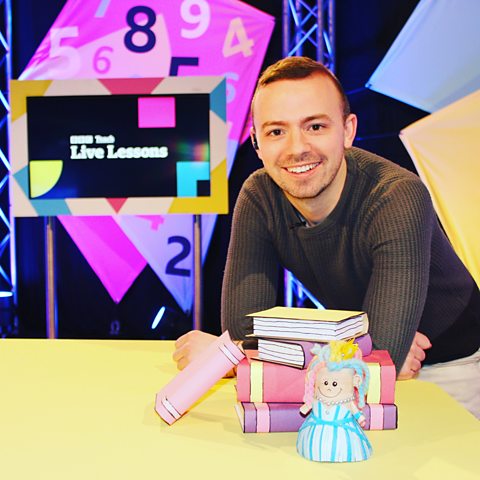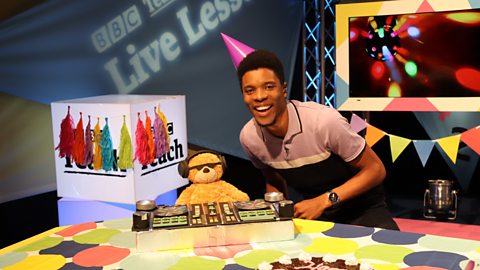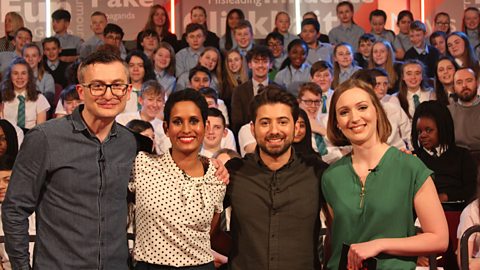Have you used Live Lessons in your classroom yet?
В鶹ԼЕД Teach Live Lessons are fun, curriculum-linked, half-hour interactive programmes to get your pupils learning in real-time alongside thousands of children from schools across the UK.
With eight new programmes confirmed for the Spring Term 2022, we asked three well known teachers to give us their tips and advice on how to best use Live Lessons to support learning. Your pupils may know Katie Brennan, Chloe Vethamony and Ryan Smith better as Mrs Brennan, Mrs Vee and Mr Smith from Bitesize Daily and Live Lessons.


Katie Brennan, KS1/KS2 supply teacher
They are always very impressed when our tweets or pictures get on the feed too вҖ“ it really helps to build their excitement!
Live Lessons are a great educational tool which can be used in class to engage and inspire children. Each lesson is crafted by a team of educational specialists and the presenting team always includes a real teacher (like me!) so you can feel confident in knowing the content is spot on.
Before the lesson, take a moment to check your tech set-up. YouвҖҷll need a good broadband connection so the programme can stream without glitching, and decent speakers so your class can see and hear the lesson clearly. The resources are available to download on the Live Lessons website, so I like to make sure I have everything printed off and ready to hand out before the lesson begins.
Ensure children have access to a pencil each for joining in the directed activities. If youвҖҷre planning for your class to sit on the carpet to watch, try to get your hands on some clipboards (perhaps one between two) so that their work stays neat and can be later stuck into books.
If youвҖҷre watching the lesson live, itвҖҷs fun to follow along with the live commentary feed on the В鶹ԼЕД Teach website. I like to do this on an iPad whilst the children watch the main classroom screen.
I show them pictures of other classes round the UK who are watching which they love вҖ“ it makes them feel connected to other parts of the country. They are always very impressed when our tweets or pictures get on the feed too вҖ“ it really helps to build their excitement!
The activities have designated moments where the children will be directed to write something down or discuss an idea with their talk partners. They do tend to get very excitable, so have your stop signal ready to go once the countdown has started!
If the task involves a bit more writing, such as writing a poem, it can always be returned to later, as the programme is available on the В鶹ԼЕД iPlayer directly after airing, as well as being available on-demand on В鶹ԼЕД Teach.
In my experience, the children really enjoy the Live Lessons. They love spotting their favourite CВ鶹ԼЕД presenters, getting involved with the activities, and seeing other primary school children on the live feed, or on the programme itself!
The shows promote great discussion topics вҖ“ I recently had a great conversation in a Year 2 class about migration and hibernation after watching the Winter Live Lesson. It felt like a really organic way to get the children using scientific vocabulary with ease.
We always have a blast making the Live Lessons, so I hope you enjoy using them in your classroom too! Happy teaching!


Chloe Vethamony, a KS2 & KS3 teaching, learning and assessment lead
While presenting the lessons I got inspiration myself on how to teach academic subjects in a more fun and engaging way.
As a teacher, I love the fact that В鶹ԼЕД Teach publish the Live Lessons schedule in advance. This is so useful as I can look ahead at the schedule page and see how the Live Lessons can be embedded into our teaching and learning curriculum for that term.
The cross curricular links for each lesson are also given, which is great for connecting the lessons with your other subjects. Knowing what lessons are coming up also means that I can include the lessons in my medium-term planning so that the whole school are aware of the upcoming lessons and all the classes can get involved at the same time. It makes an exciting change to the usual timetable!
There are handy teacher guides for each lesson. They help to prepare for the lesson and give you ideas to plan for any follow up activities if you wanted to expand on the initial 30 minute lesson. The best thing is that most episodes have worksheets that can be printed off in advance ready to use on the day as you watch along with your class.
Everything is pre-prepared which reduces the teacherвҖҷs workload and makes planning for the lessons easy and straightforward.
I was involved with the KS2 Maths and English lessons, which was such an amazing experience. While presenting the lessons I got inspiration myself on how to teach academic subjects in a more fun and engaging way. The fast pace of the lessons means that pupils' attention is held from start to finish.
The lessons are also timed perfectly to coincide with key dates within terms. My class and I have enjoyed the One Kind Word lesson that was shown during Anti-Bullying Week and the Harvest lesson that was shown in the Autumn term.
Earlier this year, we found the Safer Internet Day lesson so useful. A vital lesson that I will watch again when I get a new class.
As I'm the Curriculum and Teaching and Learning Lead for the school, I will go to the head teacher and give him the reasons why I am promoting the use of that particular Live Lesson for the whole school to use. This is fairly easy as there are only positive reasons; a fun engaging way to learn, relevant subject content, accessible for all abilities, resources and teacher guides to go along with each lesson.
Here are my top tips for planning to use a Live Lesson:
- Schedule: Make sure that you go on the В鶹ԼЕД Teach website and look at the schedule for Live Lessons. This will ensure that you have enough time to plan for your class and that you donвҖҷt miss out on any lessons.
- Use the resources: The resources are free to download and really help your class get the most out of the lesson. They are also useful to have as recorded evidence of the learning that occurred with your pupils.
- Have fun: Live lessons are so fun! They involve the whole class вҖ“ perfect for all abilities and they make the day a little different to the usual timetable. Teachers, embrace it and let the lessons take over your classroom for a morning!


Ryan Smith, KS2 teacher
You always know how the Live Lesson links in to specific areas of learning within school.
Watching Live Lessons always creates a bit of a buzz within the classroom, thereвҖҷs something special about watching a lesson that links with something real happening in the world at the same time.
Watching a World Book Day lesson on World Book Day or learning about climate change during COP26 вҖ“ it all adds to the spectacle.
Then, throw into the mix that it is presented by well-known CВ鶹ԼЕД faces to make it feel relevant for the children watching; and вҖҳrealвҖҷ teachers to co-present the shows to add a voice of educational experience - you have a guaranteed hit on your hands.
Live Lessons have a foundation built on the National Curriculum, with programmes aligned to English, maths, science, physical education, religious studies, geography, history and more. So not only do they link with a вҖҳreal-worldвҖҷ event, they are also underpinned by activities based on appropriate National Curriculum areas of study, so you always know how the Live Lesson links in to specific areas of learning.
The programmes also collaborate with experts and organisations to support the learning within the lesson. In recent lessons, Olympic athletes Emily Campbell and Alastair and Jonathan Brownlee supported the Physical education Live Lesson and the Space Live Lesson linked with physicist Brian Cox, scientist Greg Foot and the UK Space Agency. By working with experts in their field, the Live Lessons team makes sure that everything being covered within the show has the seal of approval from those who know the most about each topic.
All of these ingredients ensure that each show can take pride of place within school timetables. I know I always keep an eye out for when the next lesson is upcoming and spread the word.
Once broadcast, each lesson is made available on the В鶹ԼЕД Teach website; so if you need to revisit a particular point within the lesson, or watch it all again to re-emphasise a topic, then you can. For example, my class missed the original broadcast date of the Winter Live Lesson as we were performing our own production for parents, but weвҖҷve scheduled in an opportunity to watch it.
ItвҖҷs perfect timing (especially when you look out the window and see winter staring back at you!).
Live Lessons just adds a bit of sparkle to the day when you utilise them alongside work in the classroom вҖ“ my class certainly enjoys watching them; they like looking out for which faces they recognise; completing the work-along tasks; and of course, watching TV instead of looking at my face yet again!


В鶹ԼЕД Teach Live Lessons - 2021/2022. document
Information about our new series of Live Lessons, to bring schools and year groups together for shared learning.

В鶹ԼЕД Teach Live Lessons for primary schools. collection
Explore a range of curriculum-mapped interactive lessons for primary-aged pupils.

В鶹ԼЕД Teach Live Lessons for secondary schools. collection
Explore a range of curriculum-mapped interactive lessons for secondary-aged students.
